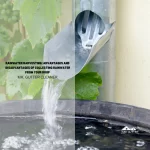Understanding the various types of gutter hangers is essential for any homeowner looking to ensure their home’s exterior remains in top condition.
Gutter hangers play a pivotal role in maintaining the structural integrity of gutter systems, directly impacting home maintenance by preventing water damage and preserving the building’s facade.
With the right selection, installation, and care, these components can significantly extend the lifespan of gutters, safeguarding the home against the elements.
This guide delves into eight distinct gutter hanger types, each offering unique benefits and suitable for different home styles and climatic conditions.
From hidden hangers that offer a sleek appearance to robust strap hangers designed for heavy-duty support, the choice of gutter hanger can influence both the functionality and aesthetic appeal of a home’s exterior
Proper understanding and selection cater to the homeowner’s intent to maintain, enhance, or upgrade their gutter system, ensuring efficient water management and contributing to the home’s overall curb appeal and safety.
What Are Gutter Hangers?
Gutter hangers secure gutters to a home’s roof, ensuring effective rainwater diversion away from the structure. These components are essential for maintaining the functionality and integrity of gutter systems, playing a crucial role in home maintenance.
Types of Gutter Hangers and Their Uses
Gutter hangers vary in design, each serving different needs:
- Hidden Hangers: Provide a clean look, fitting inside the gutter for invisible support.
- Spike and Ferrule: A traditional choice, involving a spike driven through the gutter into the fascia.
- T-Bar or Strap Hangers: Offer extra strength, ideal for heavy snow regions.
- Snap-Lock Hangers: Allow for easy installation with a snap-on system.
Table of Contents:
- What Are Gutter Hangers?
- Why Install Gutter Hangers?
- When Should You Install Gutter Hangers?
- Choosing the Right Gutter Hangers for Your Home
- Tools and Materials Needed for Installation
- Step-by-Step Guide to Installing Gutter Hangers
- Troubleshooting Common Installation Issues
- Maintaining Your Gutter Hangers
- Professional vs. DIY Gutter Hanger Installation
How Do Gutter Hangers Contribute to Home Maintenance?
Gutter hangers contribute to home maintenance by preventing gutter sagging and detachment. This protection against water overflow safeguards the foundation, landscaping, and exterior walls from water damage, underscoring their importance in a well-maintained home.
Why Install Gutter Hangers?
Installing gutter hangers is essential for ensuring gutters function correctly, directing rainwater away from the home’s foundation. This measure prevents structural damage, soil erosion, and basement flooding, underscoring the importance of gutter hangers in home maintenance.
Benefits of Proper Gutter Installation
Proper gutter installation using the right hangers:
- Prevents Water Damage: Securely attached gutters prevent overflow and water damage to the home’s exterior and foundation.
- Enhances Longevity: Sturdy hangers extend the gutter system’s life by reducing sagging and detachment risks.
- Improves Aesthetics: Neatly installed gutters contribute to the home’s overall curb appeal.
Preventing Common Gutter Problems
Effective gutter hanger installation combats common issues such as:
- Sagging Gutters: Ensures gutters remain level and firmly attached.
- Leaking Joints: Reduces the chance of leaks at gutter connections.
- Ice Dams and Blockages: Supports gutters under the weight of debris and ice, preventing overflow and ice dam formation.
When Should You Install Gutter Hangers?
The optimal timing for installing gutter hangers is crucial for maintaining your home’s exterior and preventing water damage. Identifying when to install new hangers or replace old ones ensures your gutter system remains effective and durable.
Identifying the Need for Replacement or New Installation
You should consider installing new gutter hangers or replacing old ones if you notice:
- Sagging or detached gutters, indicating that current hangers are failing.
- Visible rust or damage on existing hangers, compromising their integrity.
- After installing new gutters, as they will need hangers for support.
- Following severe weather events, which can damage or dislodge hangers.
Best Seasons for Gutter Maintenance
The best times for gutter maintenance, including installing hangers, are:
- Late spring, after heavy rains may have revealed issues with your current system.
- Early fall, before the leaves fall and rain increases, ensuring your gutters are prepared for winter.
Choosing the Right Gutter Hangers for Your Home
Selecting the appropriate gutter hangers is crucial for ensuring a durable and efficient gutter system. This decision impacts the longevity of your gutters, their performance, and the protection of your home against water damage.
Material Considerations for Gutter Hangers
The material of gutter hangers should match the gutter system’s needs and the home’s climatic conditions:
- Aluminum hangers are lightweight and resistant to corrosion, suitable for most environments.
- Steel hangers offer extra strength and durability, ideal for heavy snowfall areas.
Compatibility with Different Gutter Types
Ensure the hangers are compatible with your gutter type for a secure fit:
- K-style gutters typically use hidden hangers for a sleek appearance.
- Half-round gutters require specific hangers that fit their shape for optimal support.
- Seamless gutters benefit from hangers that can accommodate their continuous structure without causing stress points.
Tools and Materials Needed for Installation
Securing the correct tools and materials is crucial for the successful installation of gutter hangers. This preparation ensures a smooth installation process, preventing delays and ensuring the gutter system’s effectiveness and durability.
Comprehensive Checklist of Required Items
For gutter hanger installation, the following items are essential:
- Ladder: To safely reach the gutters.
- Power drill: For securing hangers to the fascia.
- Measuring tape: To ensure proper spacing between hangers.
- Gutter hangers: Selected based on gutter type and material.
- Screws or nails: For attaching hangers to the fascia.
- Level: To ensure gutters are installed at the correct angle for water flow.
- Safety gear: Including gloves and eye protection.
Where to Purchase Quality Gutter Hangers and Tools
Quality gutter hangers and installation tools can be purchased at:
- Home improvement stores: Offering a wide range of materials and tools.
- Specialty roofing supply shops: For professional-grade options.
- Online retailers: Convenient for comparing products and prices.
Step-by-Step Guide to Installing Gutter Hangers
Installing gutter hangers properly is essential for the stability and efficiency of your home’s gutter system. Follow this guide to ensure a secure installation, preventing future issues like sagging or water damage.
Preparing Your Gutters for Hanger Installation
- Clean the Gutters: Remove debris and leaves to ensure a smooth installation process.
- Inspect for Damage: Look for any signs of wear or damage in the gutters themselves, repairing any issues before proceeding.
- Gather Tools and Materials: Ensure you have all necessary tools, including a ladder, drill, screws, and gutter hangers, readily available.
Detailed Instructions for Each Step of the Installation Process
- Measure and Mark: Determine the spacing for the hangers (typically every 24-36 inches along the gutter length) and mark the positions on the fascia.
- Position the Hangers: Place the first hanger at the start of the gutter, ensuring it’s aligned with your marks.
- Secure the Hangers: Using a drill, attach the hanger to the fascia with screws. Repeat the process along the length of the gutter, maintaining the predetermined spacing.
4. Check for Level: Use a level to ensure the gutters slope slightly towards the downspout for proper drainage.
5. Final Inspection: Review all hangers for secure attachment and correct any loose areas.
Safety Tips During Installation
- Use a Stable Ladder: Ensure the ladder is on solid ground and securely positioned.
- Wear Protective Gear: Gloves and safety glasses can protect against sharp edges and debris.
- Work with a Partner: Having someone to stabilize the ladder and pass tools can prevent accidents.
Troubleshooting Common Installation Issues
Addressing common installation issues is key to ensuring the longevity and effectiveness of your gutter system. Many problems, such as sagging gutters, inadequate water flow, or detachment from the fascia, can often be traced back to the initial installation. To troubleshoot, start by checking the spacing of gutter hangers; they should be close enough (typically 24-36 inches apart) to support the gutters fully, especially in areas prone to heavy rain or snow. Ensure hangers are securely fastened to the fascia with the proper hardware, and adjust any that are loose or improperly placed. Additionally, verify that gutters have a slight slope towards downspouts for effective drainage. Addressing these common issues promptly can prevent more significant problems, such as water damage to your home’s foundation or exterior.
How to Correctly Space Gutter Hangers
Proper spacing is crucial to prevent sagging and ensure efficient water flow. If gutters begin to sag or overflow during heavy rain, it may be necessary to adjust the spacing. For most systems, hangers should be no more than 24 inches apart. In areas with heavy snowfall or ice, consider reducing this distance to provide additional support.
Addressing Problems with Existing Gutters
If existing gutters are damaged or improperly installed, assess whether they can be repaired or need replacement. Common issues like leaks at the seams, misalignment, or incorrect slope can often be corrected by adjusting hanger placement or adding new hangers for increased support. Always clear any blockages and repair leaks to ensure the gutter system functions correctly.
Maintaining Your Gutter Hangers
Regular maintenance of gutter hangers is essential to ensure the longevity and functionality of your gutter system. Proper care prevents potential issues, such as sagging or detachment, that could lead to water damage to your home.
Routine Inspection and Maintenance Tips
To maintain gutter hangers effectively:
- Inspect Seasonally: Check gutter hangers and the gutters themselves for signs of wear, damage, or loosening at least four times a year, particularly after severe weather conditions.
- Tighten Loose Hangers: Use a drill or screwdriver to tighten any loose screws or nails securing the hanger to the fascia.
- Replace Damaged Hangers: If a hanger is bent, rusted, or otherwise damaged, replace it immediately to prevent gutter misalignment or failure.
- Clear Gutters of Debris: Ensure gutters are clean to prevent undue weight on hangers, which can cause them to pull away from the fascia.
When to Replace Your Gutter Hangers
Consider replacing gutter hangers if you notice:
- Visible Sagging: This indicates that hangers may be spaced too far apart or are failing to support the gutter’s weight.
- Rust or Corrosion: Metal hangers can corrode over time, weakening their hold.
- Gutter Pulling Away From the House: This is a clear sign that hangers are no longer adequately secured to the fascia.
Regular maintenance and timely replacement of gutter hangers are crucial steps in preventing water damage and ensuring the effective operation of your gutter system.
Professional vs. DIY Gutter Hanger Installation
Deciding between professional and DIY gutter hanger installation involves assessing the project’s complexity, your skills, and the time commitment required. A well-informed decision ensures the safety and effectiveness of your gutter system.
Assessing the Complexity of Installation for Homeowners
Consider the following factors to determine if DIY installation is feasible:
- Skill Level: Basic home improvement skills are necessary for installing gutter hangers. Familiarity with tools and ladder safety is essential.
- Home’s Architecture: High roofs or complex gutter layouts may increase the difficulty and risk of a DIY project.
- Time and Tools: Ensure you have the necessary tools and sufficient time to complete the project properly.
When to Call a Professional for Gutter Installation
Professional installation may be the best choice under certain conditions:
- Safety Concerns: If working on a ladder or at heights is unsafe for you.
- Complex Installations: Homes with multiple stories, steep rooflines, or unique gutter systems may require the expertise of a professional.
- Warranty and Peace of Mind: Professionals often offer warranties on their work, providing added reassurance of the installation’s reliability and durability.


